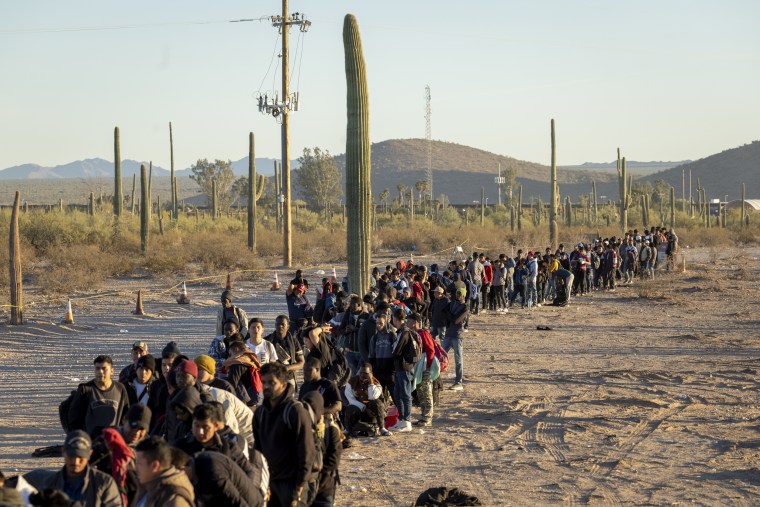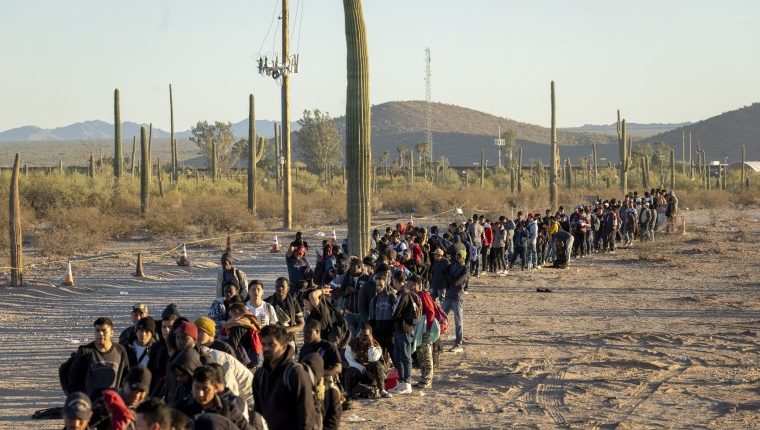A tiny town in Arizona is feeling the impact of a record number of migrants crossing the U.S. border, and the limited resources available to both U.S. and Mexican law enforcement to stem the flow.
The Lukeville, Arizona, border crossing, which was used daily by tourists headed to Mexican beaches and family members trading visits, has been closed since Dec. 4.
U.S. Customs and Border Protection closed the Lukeville Port of Entry to redeploy its officers to help agents on the front lines apprehend and process the more than 500 migrants who try to cross the border into the U.S. daily in this remote area.
On Wednesday, more than 3,000 undocumented migrants crossed in the Tucson sector, which includes Lukeville. On Thursday, NBC News witnessed hundreds of migrants, most of whom turned themselves in to claim asylum, being processed by CBP under tents in the Arizona desert, just off the highway running through Lukeville.
While major commercial trade was not affected by the closure of the port, nearby businesses that depend on the port for their livelihood are losing customers and worry they may soon have to cut staff or close.
Bernadette Nez, the general manager of the Why Not Travel Store in Why, Arizona, 20 miles north of the crossing, said she used to see over 100 customers a day. Now she’s lucky if 15 people come to the store or buy gas.
“Our sales had dropped down dramatically. Last week we made $5,000, which is what we usually would make in an eight-hour shift,” Nez said. “We had to cut hours for some of the employees as well. If this continues, we’ll have to cut down the days that we are open. That impacts your staff right around the holidays.”
A server in a nearby taco shop spoke with tears in her eyes as she talked about her fears that the store may have to close and she won’t be able to see her mother in Mexico for Christmas. Getting to her mother’s house, normally a 25-minute drive, could take seven hours if she has to use a different crossing, she said, and she’s worried about affording gas and presents.
Arizona Gov. Katie Hobbs, a Democrat, wrote President Joe Biden on Dec. 8, saying that “the federal government must act immediately to solve the unmitigated crisis caused by the Lukeville Port of Entry closure.” She suggested that National Guard members who are currently on federal active duty could be reassigned to help CBP so it would have the manpower to reopen the crossing.
A White House spokesman did not respond to a request for comment on the letter.
On Friday, Hobbs signed an executive order directing the state’s National Guard to the border, saying the federal government’s decision to close the Lukeville port had led to “an unmitigated humanitarian crisis” and “put Arizona’s safety and commerce at risk.”

Mexico and money
Data obtained by NBC News shows that the processing centers in the Tucson sector are over their capacity, at more than 130% full. Many migrants are coming from Mexico, Venezuela and Central America, but many are also coming from outside the Western Hemisphere, like Senegal.
One reason for the surge along the southwest border is Mexico’s shortage of funds, said one U.S. and one Mexican official. Millions of migrants have been intercepted, arrested, held or deported on their way to the U.S. The funding for the National Institute of Migration (INM), Mexico’s equivalent of CBP, typically runs low at the end of the year, and it is especially low after a year of record border crossings, the two officials said.
For more than five years, Mexico has been absorbing much of the strain of all migration north from Latin America to the U.S. Former President Donald Trump’s “Remain in Mexico” policy, the Covid-19 policy known as Title 42 and more recent asylum restrictions under the Biden administration have all allowed U.S. border officials to push millions of migrants back into Mexico, even if they are not from Mexico.
The decline in funds has contributed to understaffing and a drop in interdiction at the southern border, where northbound migrants enter Mexico. Up north, it has made Mexico less able to accept migrants pushed back across its northern border by the U.S.
Mexico’s INM has 35,000 agents, while the U.S. has 20,000 Border Patrol agents. The U.S. continues to send funding to Mexico to interdict illegal drugs and “irregular” migration, but Mexican President Andrés Manuel López Obrador has maintained that Mexico is under no mandate to take migrants back from the U.S. and has been doing so as a matter of cooperation.
In Lukeville, migrants keep coming, and they often show the effects of a long journey through rugged terrain. One mother told Telemundo she had to carry her daughter through the mountains to keep up with her group. Some migrants in thin jackets huddled together and even built fires by the border wall to keep warm as temperatures plunged to 40 degrees Fahrenheit overnight.
“We knew this was going to be hard. We do it for our families,” a man who recently crossed in Lukeville said.
Lukeville crossing remains closed, with no date for a reopening. On Dec. 9, another crossing closed near San Diego for the same reasons.
Source: | This article originally belongs to Nbcnews.com










